If you want to effectively communicate with customers in your market, you have to know who they are. Think about this statement in terms of a public speaker. If the speaker doesn’t know their audience, they risk choosing a topic the audience doesn’t care about, using language they won’t understand, and struggling to motivate them to take desired follow-up actions.
On the other hand, a speaker with a clear understanding of their audience can speak directly, clearly, and persuasively. So, here’s the question: how do you get to know your audience?
In a marketing context, analyzing website demographics is one way to develop a clearer view of who you’re talking to. Unpacking the data can improve your marketing strategy by allowing you to communicate more effectively with potential customers, increase audience reach, and inspire the action you desire.
What Exactly Are Website Demographics?
Broadly speaking, demographics are the characteristics of people within a group. The group of people could be as large as an entire nation or city, or as small as a school, company, or even a marketing team.
By looking at characteristics within a group, you can generate demographic data that allows you to better understand the group’s makeup.
In the case of your website, visitor demographics are the characteristics of the people who come to your site. Some common website audience demographics include:
Age Gender Geographic location Mode of access (mobile vs. desktop) Channels of access (social media vs. search engine vs. direct) Buying patternsLet’s say we’re working for a cosmetics company and one of our main competitors is Sephora.com. If we wanted to gather demographics data for our own website, we’d go straight to Google Analytics. But if we wanted demographic data about Sephora and others in the industry, we could use Semrush's Market Explorer tool to look at the age and gender breakdown of visitors to competitor’s sites and the market as a whole.
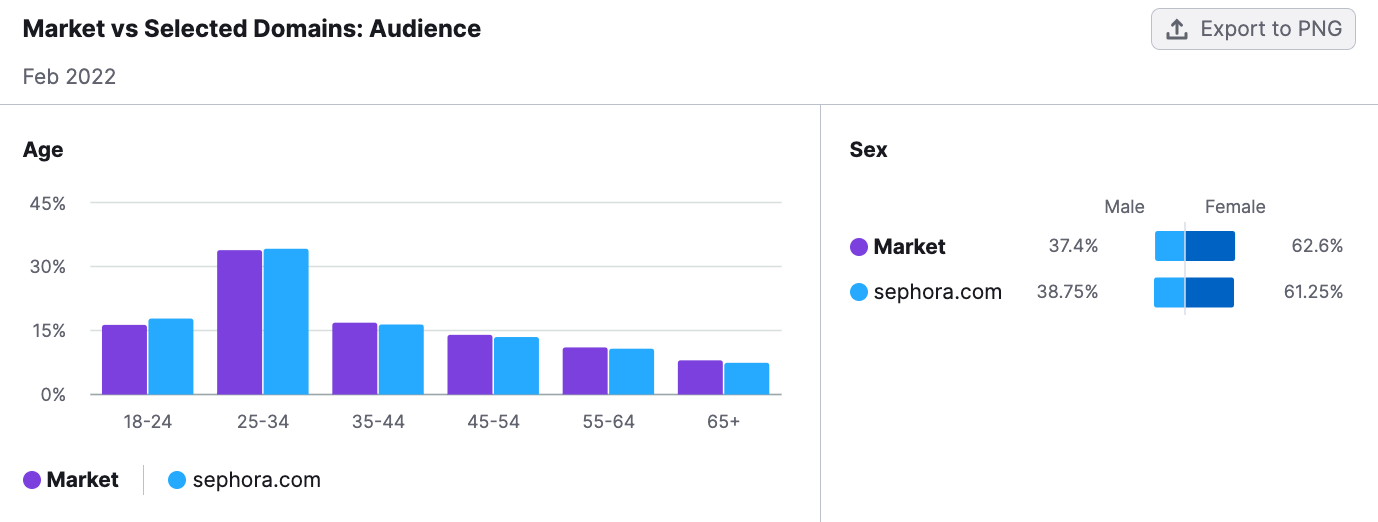
From these graphs, we can see that 61.25% of Sephora.com site visitors are female, while 38.75% are male. These numbers remain pretty close to the market as a whole, though we might be surprised to see such a large number of men visiting a site that sells cosmetics. This insight is useful since it lets us know we may want to consider men in our target audience for our own marketing campaigns.
We can also see that the largest demographic of visitors to Sephora.com are 25-34 years old. Along with this information, the graph shows they are capturing a slightly larger portion of the market when it comes to visitors who are 18-24, and slightly less with visitors over the age of 45. Even though the margins are small, it’s clear that their brand tends to skew younger. Knowing this information, we can make informed decisions about who we need to target in our own marketing efforts.
If we were interested in gaining some insight into the geographic location of Sephora.com’s site visitors, we could use the Traffic Analytics tool to view the traffic share by country.
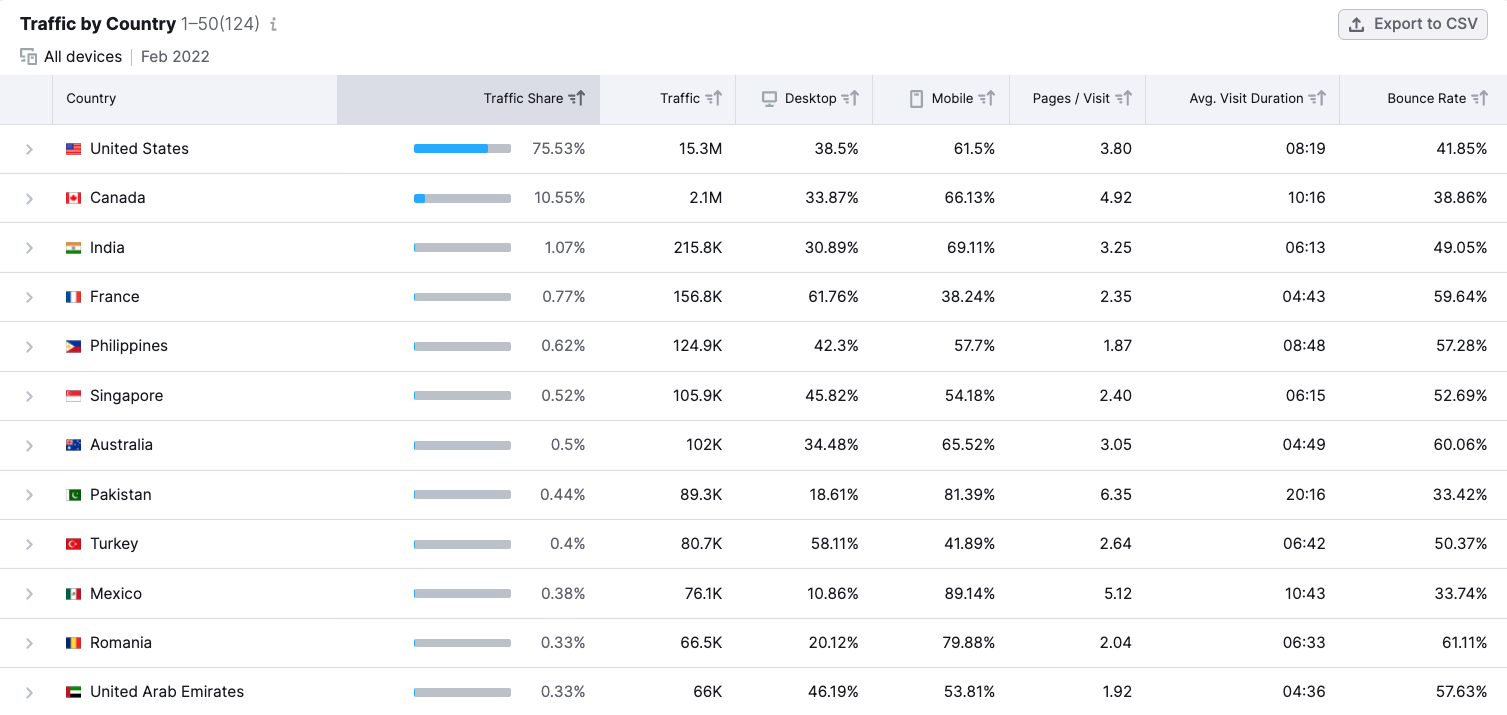
It may not be surprising to see that over 85% of traffic to Sephora.com comes from the U.S. and Canada, but we may find it interesting that traffic from India is higher than many European countries. Based on this information, if we were looking for opportunities outside of the U.S., we might look to India as a market to explore.
As these insights demonstrate, exploring demographic data with regard to visitors to your competitors’ sites can be a significant help in improving your own website target audience analysis, which will allow you to market your brand more effectively.
What Can Demographics Do for Your Target Audience Analysis?
Once you have an understanding of the demographic data for your competitors and the market as a whole, you can use this information to refine your audience analysis and strengthen your own marketing strategy.
While there are numerous ways to leverage demographic data, here are three examples of how it can improve your marketing:
Attract new customers — Knowing who visits competitor sites (and who doesn’t) can help target your marketing efforts to attract new customers. Discovering a particular demographic gap in your audience can help you figure out where to focus your marketing efforts. Likewise, discovering a trend can help you know where to double down. Provide what people want — Understanding the needs and desires of people in your market allows you to provide the information, products, and services people are looking for. Once you know who’s visiting your competitors' sites, it’s easier to make educated guesses about what those people want when they visit your site. Speak your audience’s language — Using language that feels familiar to your audience helps build trust. Demographic information about people in your market lets you study the specific issues they face, the desires they have, and the ways they communicate about those desires and issues. Trust us, female Gen Z visitors talk about their issues in a different way than male Boomers. Talking to your customers about their needs and desires in their own language can make a world of difference.Start with Age and Gender in Website Target Audience Analysis
When it comes to leveraging demographics for your marketing strategy, age and gender are two crucial characteristics to consider. A site visitor’s age and gender can tell you a lot about what they are looking for, how to talk to them about it, and how to meet their needs.
Gender — The most common genders when it comes to demographics are male and female. Some people, however, identify as non-binary or prefer not to answer questions about gender. Though a smaller number of visitors will identify as non-binary or prefer not to answer, it’s important not to ignore this data when it comes to your audience analysis.Regardless of how your audience identifies, gender identity has a big impact on how people relate to themselves and the world around them. Research has shown that men, women, and non-binary folks respond differently to various uses of language, colors, images, and other media. This becomes an incredibly important point when marketing to different groups.
Here are two examples of how language differs between ads marketed to women as opposed to men:
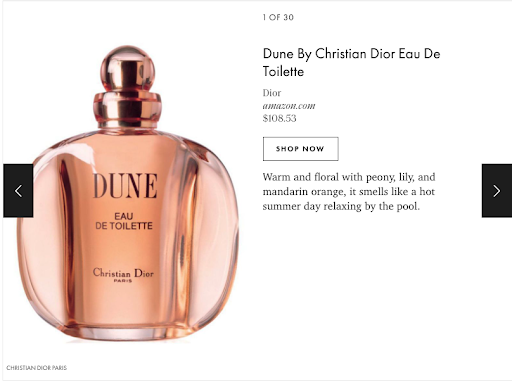 Source: Elle.com
Source: Elle.com Notice the passive language used in this perfume intended for a female audience. They claim it smells like, “Relaxing by the pool.”
 Source: Dior.com
Source: Dior.com Compare with the language used for this cologne intended for men. The marketers use strong adjectives like “Powerful” and “Raw.”
Age — Site users are typically grouped into generational sub-categories. Boomers, Millennials, Gen Z, Gen Y, and Gen X are all examples of age groups. While there is variation within age groups, knowing what group your users fall into can help you hypothesize about their values, needs, desires, interests, and ways of using the internet.Studies of social media users show that certain platforms appeal to different age groups. This can be an asset when planning marketing campaigns. For example, a campaign to attract younger customers may fare better on TikTok than Facebook. Or an effort to attract more young males may be more successful on Twitter than Instagram.
If we compare the social media strategy of two sites with different age demographics — Sephora.com and JCPenny.com — the distinction becomes clear.
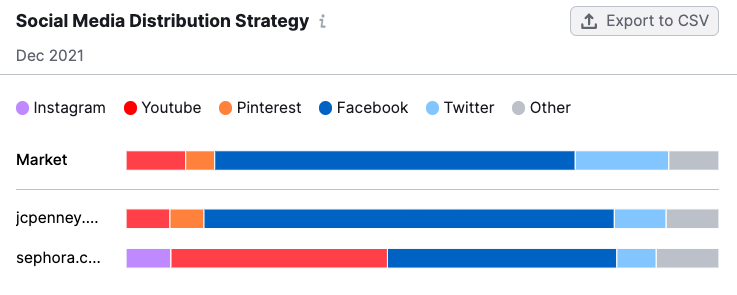
Here, we compared social media distribution between Sephora.com and JCPenny.com. As mentioned, Sephora tends to skew slightly younger in terms of age than others in their industry. For example, 17.8% of people visiting Sephora.com are aged 18-24, while only 12.4% of JCPenny visitors are in the 18-24 age range.
Based on the charts above, we can see that Sephora has a larger presence on Instagram and Youtube, while JCPenny has a larger presence on Facebook. The choice of these social media platforms tracks with these age demographics. Depending on our target audience, we could look to our competitors strategies to make better decisions about our marketing efforts.
Why Comparing Demographic Data with Your Competitors Is Crucial
While understanding your own website demographics is important, comparing your data with your competitors can provide key insights that can make you more competitive in the larger market.
Comparing your demographics with those of your competitors allows you to study:
Where your audience overlaps with your competitors Where your audience and your competitors’ audience are different Where your efforts are succeeding or failing What portion of the relevant audience you haven’t yet engagedWhen it comes to expanding your audience, knowing where your target audience spends their time online can help you make important decisions about where to direct your marketing efforts. Let’s look at an Audience Overlap graph to see what insights might be gained.
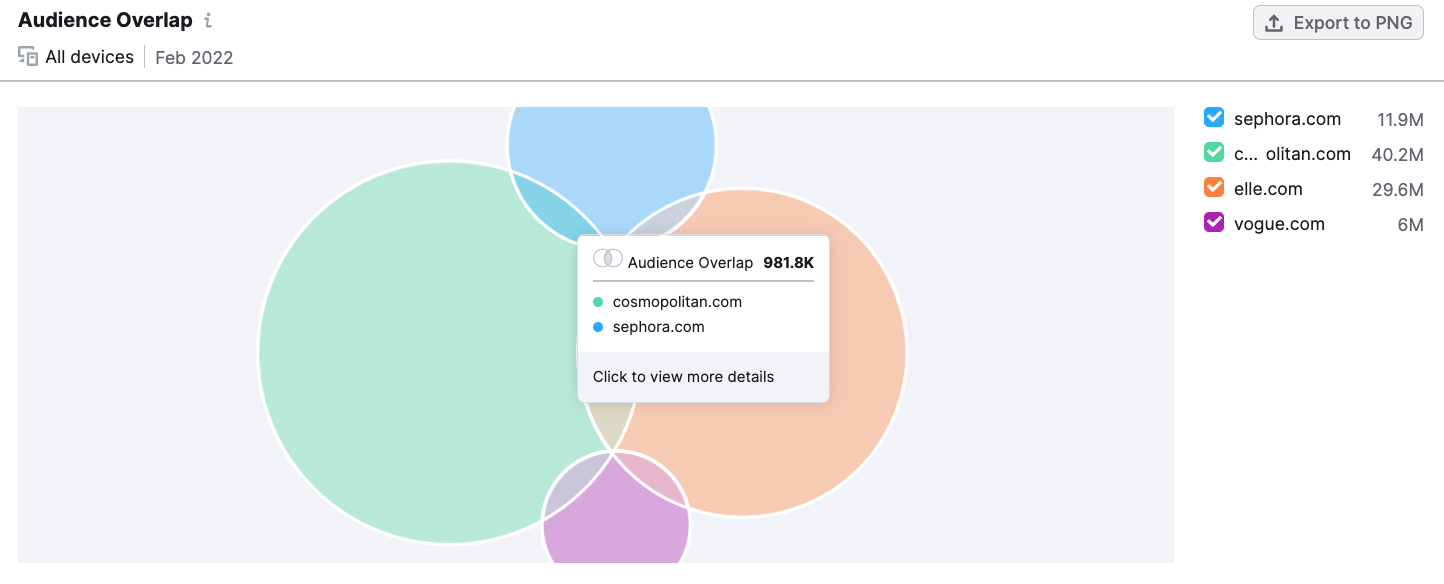
As the Audience Overlap graph shows, 981.8K people who visited Cosmopolitan.com also visited Sephora.com. While this number suggests that the brands are already adjacent to each other, we can see that the green circle representing Cosmopolitan.com has a large audience that is not yet shared with Sephora.com. If we are looking to expand our audience and capture some of Sephora’s customers, we might place ads in Cosmopolitan knowing that there is already some overlap and a lot of room to grow in that market.
Viewing Visitor Demographic Data for Your Competitors’ Sites
There are many ways of getting demographic data for your own website. The most common software for collecting demographics data is Google Analytics. Likewise, some website building and hosting services like Squarespace offer built-in analytics software that provide insights about your website demographics.
The limitation of Google Analytics and other analytics software is that these tools don’t allow you to view data related to your competitors. This is the real value of Semrush’s Market Explorer or Traffic Analytics tools. With these tools, you are able to view competitive digital insight for any website across 190 countries and regions.
Moreover, with these Semrush tools, you’re able to view demographics data among different sites on a single dashboard. For example, if we wanted to view the age and gender distribution among Sephora’s competitors, we could use the Benchmarking Report in the Market Explorer tool. Benchmarking allows you to enter up to 5 competitors and view data points side by side.
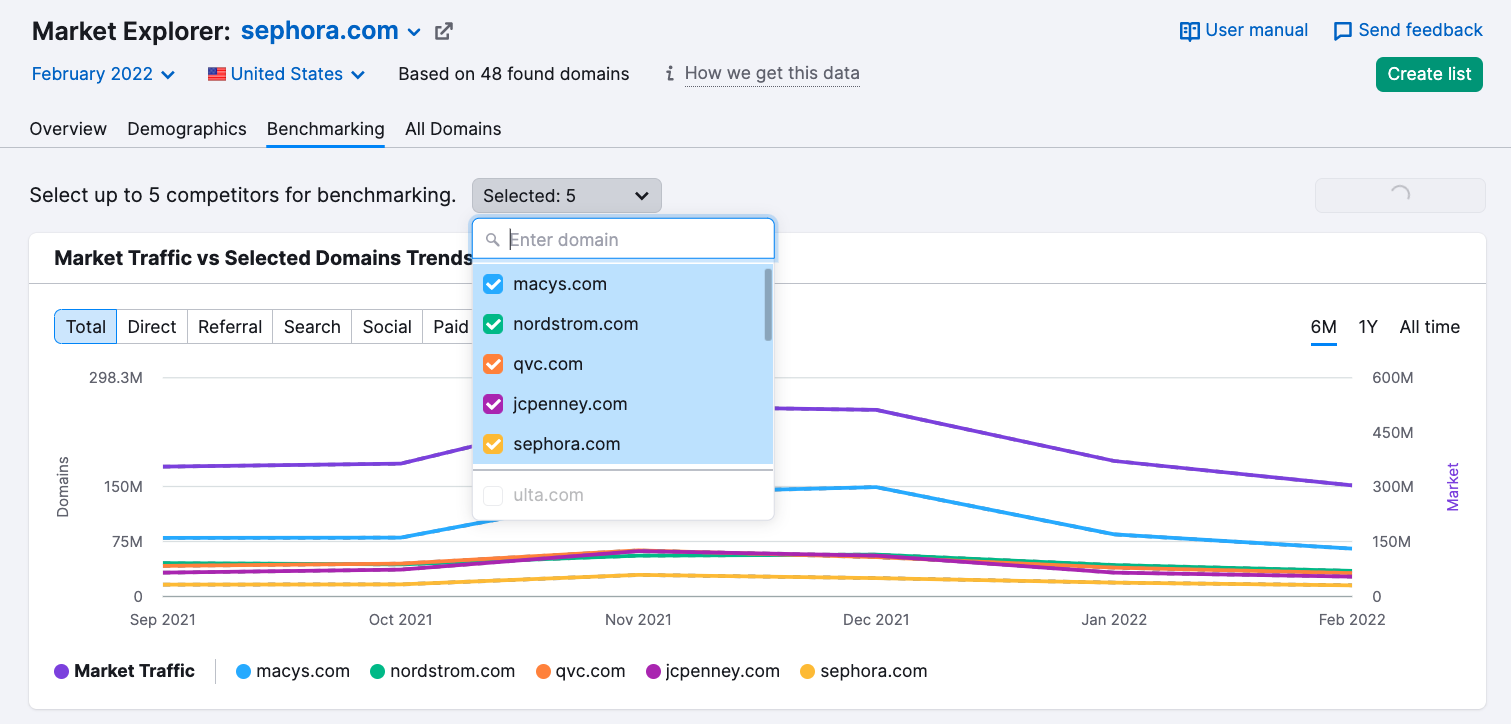
In this example, we will compare five of the top websites for our market: Sephora.com, Macys.com, JCpenny.com, Nordstrom.com, QVC.com, and Ulta.com. After selecting these competitors, the Market Explorer tool creates a number of graphs that offer demographic insights.
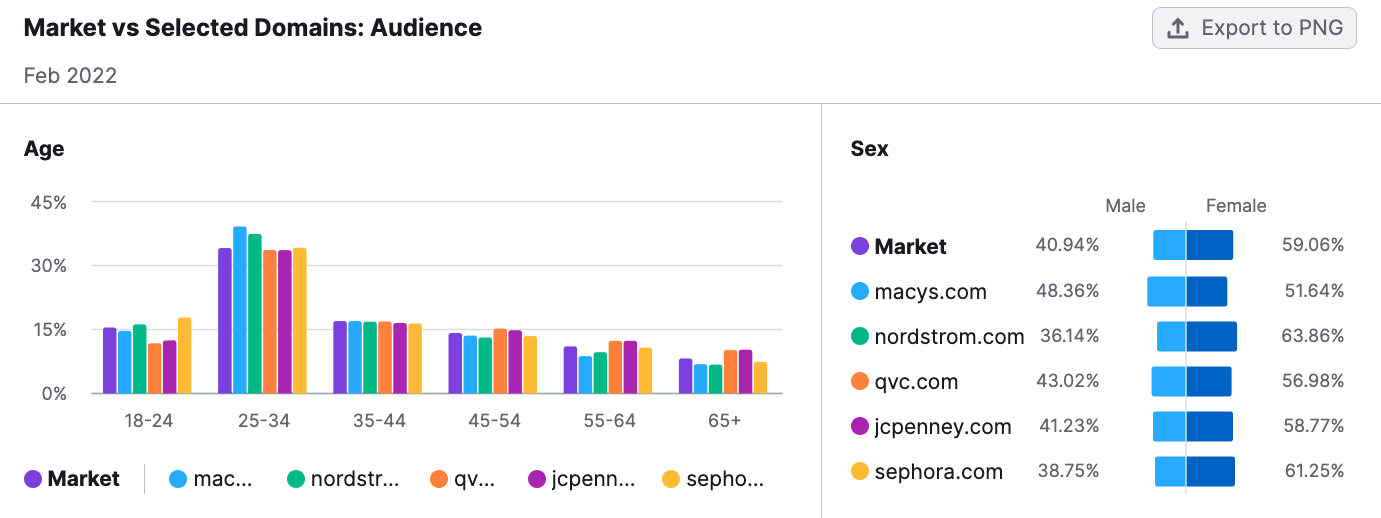
As you can see, these graphs depict demographics data for several websites in a given market alongside those of the competitors.
Ultimately, it’s important to collect data from as many places as you can to build the most complete picture of your site’s demographics. For example, tracking visitor demographics alongside different website’s traffic sources can produce interesting insight into where you can improve your own strategy.
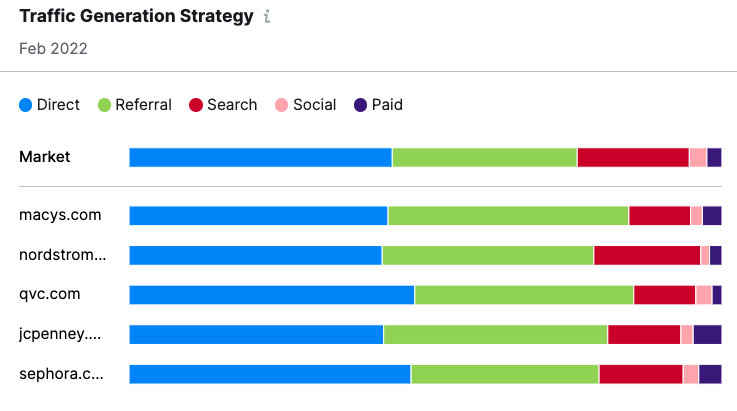
We can see from this Traffic Generation Strategy graph that QVC.com is the leader when it comes to direct traffic (23.6%), indicating that their brand awareness is strong. We can also see that Nordstrom.com does well with search traffic (28.45%), suggesting their SEO strategy is working for them. With these insights in mind, we might look to these other brands for ideas on how to improve our own traffic generation strategy in order to capture some of their visitors.
Putting It all Together: Website Demographics and Your Marketing Strategy
To market effectively, you need to know who you’re talking to. A clear picture of your website demographics and the demographics of your competitors’ sites lets you communicate more effectively with your customers, uncover gaps in your targeted audience, and understand how to expand your reach.
When you’re first starting off, the number of different demographics you can track can be overwhelming. Begin with the highest impact data. Though we suggested age and gender as a good place to start, different demographic options might make more sense depending on your specific business goals.
But be careful not to make assumptions as you strategize. For example, it would be easy for cosmetics companies to assume gender isn’t an important metric to measure since all of their products are tailored to women.
In making this assumption, however, marketers miss those men who come to the website shopping for gifts for the women in their lives. In this case, analyzing the data may lead to some interesting findings! Keep an open mind and let the numbers do the talking.
No matter where you begin, continually engaging with the data is tremendously important. Trust us, your competitors look closely at who’s visiting their website. And chances are they’re also doing website audience research on your site’s traffic as well. Marketing success depends on staying ahead of the curve and adjusting your strategy as new trends emerge.
Innovative SEO services
SEO is a patience game; no secret there. We`ll work with you to develop a Search strategy focused on producing increased traffic rankings in as early as 3-months.
A proven Allinclusive. SEO services for measuring, executing, and optimizing for Search Engine success. We say what we do and do what we say.
Our company as Semrush Agency Partner has designed a search engine optimization service that is both ethical and result-driven. We use the latest tools, strategies, and trends to help you move up in the search engines for the right keywords to get noticed by the right audience.
Today, you can schedule a Discovery call with us about your company needs.
Source:





